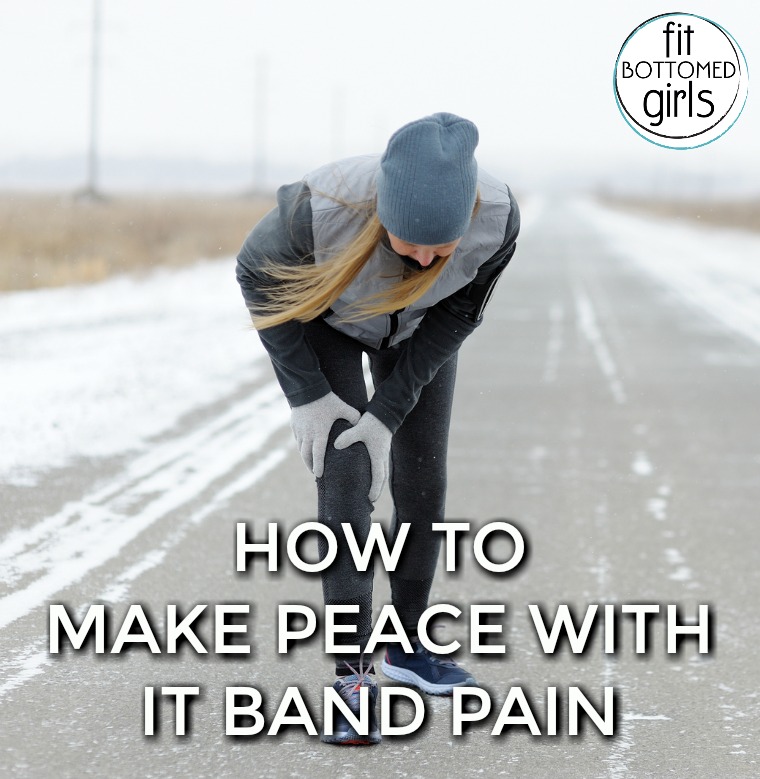How to Make Peace With Your IT Band

Of all the nagging pains I hear runners complain about, IT band pain seems to be the most common. To make things worse, it’s one of those injuries that with time and rest goes away, only to return again when you least expect it. I get it. I played this silly game for years.
While the pain and frustration may leave you wanting to curse your IT band, it’s actually not your IT band’s fault that you’re hurting — typically it’s merely symptomatic of a larger problem.
To understand the real reason why your IT band might be perpetually angry, let’s back up a few steps.
What Is the IT Band?
The iliotibial (IT) band is a thick tendon that attaches to your tensor fascia latae (TFL) — a relatively small muscle at your outer hip — and runs down your leg, connecting to the outside of your knee. When it gets inflamed, it typically manifests as pain at the outside of your knee when your knee is bent. It’s often mistaken by runners to be a potential knee issue, but just because the pain is at your knee doesn’t mean the problem is there. In the case of IT band pain, that’s simply where the tendon rubs.
Why Does It Get Cranky?
In some of the milder cases, the solution might be as simple as buying new running shoes to control the amount of pronation (rolling inward) in your feet or not running on a surface that’s banked, which forces one of your legs to be slightly higher than the other.
However, most often, I’ve found the underlying cause to be related to insufficient hip strength and stability. To tell if this might be the case for you, look at pictures of you running, particularly toward the end of a race. Look past the am-I-there-yet grimace and zero in on the positioning of your hips. Notice if one of your hips dips lower than the other. You can tell by looking at whether the waistband of your running shorts is level when only one leg is supporting you.
When one hip dips, the IT band is in a super stressed position — lengthened to maintain your center of gravity and protect the alignment of your skeleton. In my experience, this is usually traced back to laziness in the muscles responsible for controlling the stability of your hips, particularly the gluteus medius and maximus.
If these two glute muscles are asleep, other muscles try to do their jobs. But sadly, no other muscle is designed to be the powerhouse that your glutes are so things farther up and down stream start to get a bit wonky.
Just to make this all even more fun — as counterintuitive as it may seem — it’s totally possible to have the IT band that hurts be on your stronger and more stable side. When your weaker side lacks sufficient hip strength and stability, the stronger side tries to pitch in and help. Depending on the severity of the hip dip, you may find that your “good” side gets angry because it always has to take up the slack of your weaker hip.
How to Make Peace With Your IT Band
To take the pressure off your poor IT band, you need to stabilize your pelvis by getting your gluteus medius and maximus back online and pulling their own weight.
To do this, I recommend exercises that work each side of the body independently. Since running is a one-leg-at-a-time movement, it only makes sense to make sure that each side of your body is responsible for doing its job without being able to rely on the strength and/or stability of the other side.
Here are some of my favorite moves:
- Hip Hikes: Stand with your left leg on a step and your right leg directly beside the left leg, hovering off the step. Drop the hip of the right leg as far as possible while keeping your shoulders level and hips squared forward.
- Clamshells: Lie on your right side, legs bent at 45 degrees, hips, knees and ankles stacked, heels together. Using your glutes, lift your left knee away from your right knee as high as you can without moving your pelvis or separating your heels.
- Single-Leg Squats: Stand on your right foot in front of a chair with your left foot lifted off the ground in front of you. Press your hips back and tap your butt on the edge of the chair, standing knee tracking over your second and third toes. Use your glutes to return to standing.
Do 2 to 3 sets of 8 to 12 reps of each move per side every other day. If you notice which side is weaker when doing these moves, I recommend doing a few extra reps on your weaker side until you feel a little like the strength on both sides is more similar and balanced.
Have you ever dealt with IT band pain? —Alison
